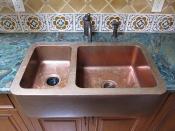Laboratory #8 The Sequence of Chemical Reactions
Drew Selfridge
Dave Allen, Lab partner
Instructor Yang
February 11, 1997
INTRODUCTION
This experiment was to recover the most amount of copper after it is subjected to a sequence of reactions. The copper is originally in solid form, but the reactions will turn it into free Cu+2 ions floating in solution. The ions will then be regrouped to form solid copper once again. During this process, however, some of the Cu+2 ions may be lost. The copper will subjected to changes in pH and heat. These steps were responsible for the breakdown and reconstruction of the copper. The percent of copper retrieved will reflect the skill with which the reactions were administered.
EXPERIMENTAL
On an analytical balance, measure the mass of the copper while in the vial. Remove approximately 0.35 g into a 250 mL beaker. check the balance and record the mass of the remaining mixture in the vial.
In the laboratory hood, dissolve the copper with ~ 3 mL of nitric acid. Allow the beaker to remain under the hood until the fumes cease. The remaining solution should be blue. Bring the beaker back to the lab station and add ~ 10 mL of distilled water. Stir the mixture, all the while adding ~ 8 mL of 6M of NaOH to the beaker. Check with litmus paper to ensure that it is slightly basic. Fill the beaker with up to 100 mL mark with distilled water. Heat the solution and allow it to boil for 5 minutes. Prepare a squirt bottle with hot water. Filter the solution and rinse the beaker with the hot water. Rinse the filter cake with hot distilled water. Transfer the filter paper into a clean beaker. Add ~ 10 mL of 3M sulfuric acid to the...


